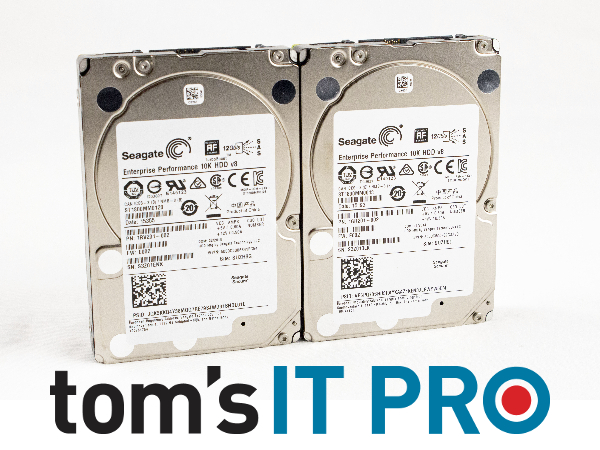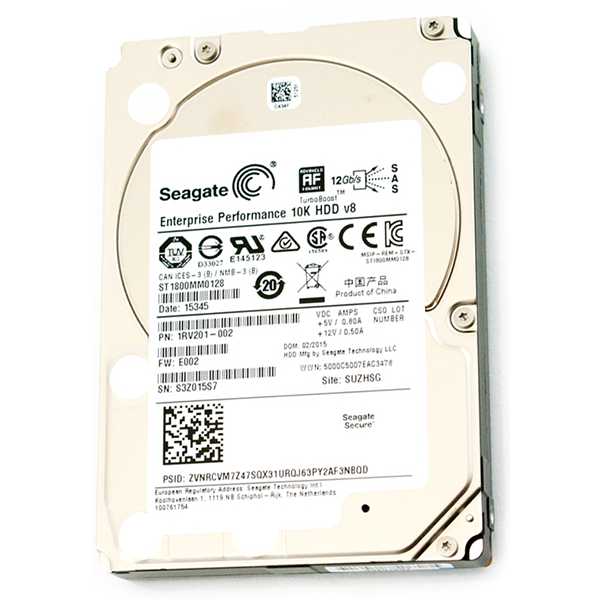Seagate Enterprise Performance 10K v8 & TurboBoost HDD Review
Seagate pioneered the SSHD, which marries the capacity of an HDD with the performance of an SSD. Tom's IT Pro tested the company's new 10K Enterprise drive.
The latest popular trend in the enterprise storage world consists of crowds of pundits loudly pontificating that "The end of disk is Nigh!" Lately the noise level has reached a deafening crescendo....another day, another article proclaiming the bloody end of the HDD world at the hands of powerful SSDs.
Reality isn't quite as clear cut. In fact, cold hard statistics specifically state otherwise. SSDs are penetrating the upper end of the performance-based spectrum, but the ongoing data explosion assures there is enough room for both storage mediums, at least for now. In other words, the SSD insurrection is going to take awhile.
The HDD vendors hear footsteps, however, and know they must continue to march forward by increasing HDD density, which reduces cost. Cost is still overwhelmingly in the HDD's favor — in some cases, an enterprise HDD is as low as 3 cents-per-GB, while most enterprise SSDs are well over a dollar.
However, density alone isn't going to save the day. Seagate pioneered the SSHD movement, which infuses a small amount of NAND on an HDD to combine the capacity of an HDD with the explosive performance of an SSD. This move began in the client space for desktop applications, and Seagate transplanted the technology into its high-end 15K HDDs to help boost performance for demanding enterprise workloads.
Seagate conservatively released a second-generation 15K SSHD product into its enterprise stack last year, but now that the approach has proven its viability, the company is pushing SSHD products downward into its popular Enteprise Performance 10K v8 products under the TurboBoost moniker.
Come along as we the take the new 10K spinners for a flashy ride and test the capabilities of the new SSHD products at Tom's IT Pro.
Paul Alcorn is a Contributing Editor for Tom's IT Pro, covering Storage. Follow him on Twitter and on Google+.
Get Tom's Hardware's best news and in-depth reviews, straight to your inbox.
Follow Tom's IT Pro on Twitter, Facebook, LinkedIn and Google+.

Paul Alcorn is the Editor-in-Chief for Tom's Hardware US. He also writes news and reviews on CPUs, storage, and enterprise hardware.
-
Quixit Seagate actually only pioneered the term "SSHD", Samsung had the first commercially available hybrid hard drive.Reply -
hannibal Maybe so, but this HD is really good! Just have to hope that consumer level HD:s will also get these bumps!Reply -
JackNaylorPE Back in the day, I used 15k Seagate drives in all my workstations w/o a significant cost premium. After hours they were gaming boxes. I'd still buy them today if there was a reasonable cost premium. Been putting SSHDs in all workstation / gaming builds for a while about a third w/ no SSDs .... haven't bough a HD in 4 years.Reply -
SteelCity1981 HDD's are not going anywhere anytime. so while SSD's perform a lot better, in read write, HDD's on the other hand have the capacity SSD's simply can't match esp when it comes to price per GB.Reply -
JackNaylorPE SSHDs provide a "best of both world's" scenario....tho an SSD for OS and apps and SSHDs for data and games rocks. A typical user works on the same files / plays the same games in streaks of time and the SSHD logic putting most frequently used stuff on the SSD portion works real well here.Reply
In the office, I may spend a few weeks working on a short list of CAD drawings which will sit day after day on the SSD portion of the SSHD....as I move on to a new project, the old files get moved off the SSD portion and new ones get moved on. When playing FC3, the far Cry files sit on the SSD portion and when I move on to a new region or FC4, the old ones again get moved to the slow portion of the drive and the new ones on.
Of course if you work or play random things every day, then the benefit is much less. -
alidan ReplyHDD's are not going anywhere anytime. so while SSD's perform a lot better, in read write, HDD's on the other hand have the capacity SSD's simply can't match esp when it comes to price per GB.
they are honestly getting close to the point that for a normal person you could justify the cost premium with piece of mine due to no mechanical failures.
personally my ideal set up would be
ssd boot - check
hdd mass storage - check
ssd game - no check - few games would really benefit from ssd, but damn would it be nice for the ones that do
ssd mass image storage / porn - no check - im going on somewhere around 1-2 million images and sorting them is kind of a nightmare on a hdd due to loading folders times, at worst it can be around 5 minutes for some. -
tom10167 an enterprise is not a normal person. Even if SSDs were 50% off tomorrow with an unlimited supply there are tons of companies that still wouldn't switch.Reply -
cats_Paw Seagate is the worst HDD company closly followed by western digital.Reply
They have the highest failure rate, and the worst performance.
There is a reason they spend so much money on advertising their HDDs, because other way noone would buy em.
Hitachi, Samsung. Those are the companies you want for HDDs (but obviously this can change in a blink of an eye if the next models suck). -
JackNaylorPE If your using the backblaze data for your source, it's totally irrelevant. The bonehead who put consumer drives in a server application you would think should be fired. My guess is they got them so cheap, it's more cost effective to use 5 consumer drives than buy one enterprise drive.Reply
Consumer drives have a feature called head parking which moves the heads away from the spinning platter to protect them from vibration and an accidental desk bump. Each drive is rated for a certain number of parking cycles ..... server drives are not subject to desk bumps and are vibration isolated if designed correctly so the "consumer protection feature" actually decreases reliability in a server as they many see 50,000 cycles in a month.
So lets look at some "real data" indicating drives returned 6 - 12 months into the warranty period.
http://www.hardware.fr/articles/927-6/disques-durs.html
- Seagate 0,69% (contre 0,86%)
- Western 0,93 (contre 1,13%)
- HGST 1,01% (contre 1,08%)
- Toshiba 1,29% (contre 1,02%)
Top 5 failure rates
- 4,76% WD Black WD4001FAEX
- 4,24% WD Black WD3001FAEX
- 3,83% WD SE WD3000F9YZ
- 2,56% HGST Travelstar 7K1000
- 2,39% Toshiba DT01ACA300
and for the next reporting period
http://www.hardware.fr/articles/934-6/disques-durs.html
- Seagate 0,68% (contre 0,69%)
- Western 1,09% (contre 0,93%)
- HGST 1,16% (contre 1,01%)
- Toshiba 1,34% (contre 1,29%)
Top 5 failure rates
- 4,58% WD Red WD60EFRX
- 3,40% Toshiba 3 To DT01ACA300
- 2,93% WD Green 4 To WD40EZRX
- 2,78% WD SE 3 To WD3000F9YZ
- 2,14% Hitachi Ultrastar A7K2000 1 To
For enterprise drives
- 0,00% Seagate Enterprise Value ST2000NC001
- 0,00% Seagate Enterprise Capacity ST2000NM0033
- 0,00% Seagate Enterprise Value ST3000NC002
- 0,00% Seagate Constellation ES ST4000NM0033

